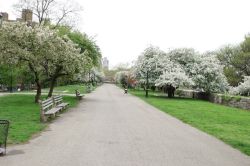Riverside Park
Cherry Walk
Cherry Walk is part of Riverside Walk, a continuous four-mile-long path along the Hudson River from 72nd to 158th Street. Named for the cherry trees (Prunus) along the path between 100th and 125th Streets, this part of Riverside Park was added in the 1930s when the park was expanded by filling in the river as part of the construction of the West Side Highway.
Riverside Park, one of only eight officially designated scenic landmarks in the City of New York, has a long and storied history. The rugged bluffs and rocky outcroppings once descended directly to the Hudson River shore and were densely wooded during the Native American habitation. In 1846 the Hudson River Railroad was cut through the forested hillside. Acknowledging the city’s expansion northward, Central Park Commissioner William R. Martin proposed in 1865 that a scenic drive and park be built on Manhattan’s Upper West Side. The land between the heights and the railroad was acquired by the city over the next two years.
Frederick Law Olmsted (1822–1903), renowned co-designer of Central and Prospect Parks, was retained in 1873 and submitted a plan in 1875 combining park and parkway into a synthesized landscape which adhered to the general topographical contours of hill and dale. Over the next twenty-five years park designs developed under a succession of landscape architects, including Olmsted’s partner Calvert Vaux (1824–1895) and Samuel Parsons (1844–1923). The result, stretching then from West 72nd to 125th Streets, was a grand tree-lined boulevard; an English-style rustic park with informally arranged trees and shrubs, contrasting natural enclosures, and open vistas.
Originally this part of the park was home to railroad tracks and unsightly dumps. In 1894, state legislature expanded Riverside Park to include the blighted land, and the Parks Department and neighborhood residents became involved in the renovation of the area.
In 1909, a naval parade from New York City to Newburgh, New York, in honor of the Hudson-Fulton Celebration began from this part of the river. The 18-day celebration commemorated the 100th anniversary of Robert Fulton’s (1765–1815) demonstration of steam-power on the Hudson River and the 300th anniversary of Henry Hudson’s (d. 1611Α) discovery and exploration of the river. As part of the celebration, the Committee of Japanese Residents of New York presented 2,000 cherry trees as a gift to the city. The surviving trees of the original planting of 700, part of the same batch of trees planted in Washington, D.C.’s Tidal Basin, can be found elsewhere in Riverside Park, in nearby Sakura Park, and Central Park.
Plans to improve the site were first proposed in the early 20th century, and when the railroad expanded from two to six tracks, New York Central Railroad, under pressure from nearby residents, consented to covering the tracks. Plans to reconstruct the area took a twist, however, with the construction of the West Side Highway. Several “West Side Improvement” designs were proposed; an earlier plan by the noted architectural firm McKim, Mead and White placed the proposed parkway over the train tracks. Robert Moses (1888–1981), who first noticed the site’s potential as a fledgling civil servant, made transforming the waterfront one of his top priorities when he became Parks Commissioner in 1934. Moses opted instead to use the top of the enclosed train tracks for parkland, allowing the roadway to wend through the landfill-reinforced riverbank.
Under Moses’s direction, Gilmore D. Clarke and Clinton Lloyd, Parks landscape architects, designed a plan that afforded automobile drivers scenic views of the river while adding recreational facilities such as playgrounds and ball fields along the new expanse of land between the tracks and roadway. The West Side Improvement plan was completed in 1937 and added 132 acres to the park. The new landscape differed from Olmsted’s typically English garden design, utilizing the wall that covered the tracks as a backdrop for the new recreation features.
This link in the Hudson River Valley Greenway was completed in 2001, is part of one of several designated “greenways” in New York City on which only bicyclists and pedestrians are allowed. The project, which included an additional 35 new cherry trees, was funded by the Federal Intermodal Surface Transportation Efficiency Act (ISTEA) and the State Environmental Quality Bond Act. Part of the greenway system first envisioned by Commissioner Moses trails on the Hudson River Valley Greenway which eventually will stretch from Battery Park in Manhattan to Battery Park in Waterford, New York.
Check out your park's Vital Signs
Clean & Safe
Green & Resilient
Empowered & Engaged Users
Share your feedback or learn more about how this park is part of a
Vital Park System

Know Before You Go
Related inquiries may be sent to boatbasin@parks.nyc.gov
Related inquiries may be sent to boatbasin@parks.nyc.gov


